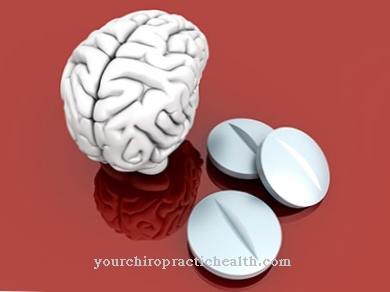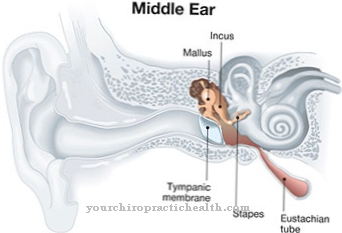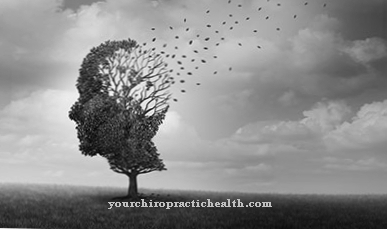Deafness is a common ailment. If one considers the total population from infants to old people, one can assume that on average around the world around ten percent of all people suffer from hearing disorders. Not all of them need to see a doctor because of this, but at least three percent of the total population needs medical treatment.
causes

The natural deterioration in hearing begins in otherwise completely healthy people, shortly after the maturity period. Especially in the hearing organ, the greatest functional efficiency of which is at the end of the second decade of life, the decline in age that begins in the third decade can be determined very early.
Of course, the regression process is very different from one individual to the next and also depends on other stresses to which the human being as a whole is exposed, especially the hearing organ. The so-called old-age hearing loss is by no means the main cause of all hearing disorders, but all people who reach old age will one day suffer to a greater or lesser extent from the changes in age of the hearing organ.
It is well known that there are many causes that can cause hearing loss. In addition to the already mentioned age reduction, the following must be mentioned above all: otitis media of both acute and chronic nature, otosclerosis, accidental damage of various kinds in the head area, noise damage, various infectious diseases, diseases of the upper ones Airways in infants and small children, ear malformations, damage to the auditory nerves from drugs or other harmful substances, congenital hearing disorders, acute hearing loss in middle age and various others.
Symptoms, ailments & signs
The first signs of incipient hearing loss or hearing impairment are often unfamiliar difficulties in conducting a conversation. The person concerned has problems understanding and therefore has to ask several times. Conversely, listeners and conversation partners ask to speak a little more quietly. Conversations become increasingly exhausting.
This is especially true for phone calls. Symptoms of hearing loss usually develop slowly and insidiously. Quiet noises that come from nature are barely noticed. This includes the chirping of birds, the sound of the sea or the noise of the wind. Radio or television must always be turned up.
Enjoyment of leisure activities such as attending events or television programs is only possible to a limited extent due to the hearing problems. Background noises make conversation more and more difficult. As the illness increases, noises in the household, such as the refrigerator starting on or the doorbell ringing at the front door, are heard less and less.
Even morning alarm sounds are no longer heard. In the case of noise-related hearing loss, typical symptoms include ringing in the ears. Some people feel as if they have a foreign object in their ears.
When hearing impairment occurs suddenly, only one ear is usually affected. With otosclerosis that starts slowly, symptoms such as ringing in the ears and cracking noises in one ear also initially occur. In most cases, these symptoms appear in both ears later on.
Especially people with otitis media require constant medical treatment. The acute and recurring short inflammatory phases are treated conservatively by every doctor, partly with the usual physical therapy, partly with the help of modern drugs that are counted as chemotherapy or antibiotics. An acute suppuration of the middle ear, which leads to inflammation of the entire mastoid process, used to be treated only surgically.
Complications
As a rule, these complaints have a very negative effect on the quality of life of the person affected. The patients suffer from considerable restrictions in their everyday life and, in serious cases, are also dependent on the help of other people. The further course of these diseases depends heavily on their cause, so that a general course cannot be predicted.
Especially in children, this can delay development, so that complications and complaints can also arise in adulthood. The diseases do not have to be treated in every case. Nor do they always necessarily represent a health risk. A direct and causal treatment of these disorders can only be carried out in a few cases.
The symptoms can be alleviated and limited, especially with the help of technical devices and hearing aids. However, a complete hearing loss can usually no longer be made irreversible. There are no particular complications with the treatment itself.
In most cases, the patient's life expectancy is not reduced or otherwise influenced by these symptoms. Often, however, the patients also suffer from psychological complaints and therefore need psychological treatment.
When should you go to the doctor?
If you have a hearing loss, hearing impairment or otosclerosis, you should always consult a doctor. There will be no self-healing, so that those affected are always dependent on medical treatment from a doctor. An early diagnosis with early treatment has a positive effect on the further course of the disease and can prevent further complications.
If you have a hearing loss, hearing impairment or otosclerosis, you should see a doctor if you experience hearing problems that do not go away on their own. This can lead to a whirring noise or other annoying noises in the ear, which can significantly reduce the quality of life. In many cases, the feeling of a foreign body in the ear indicates these diseases and should then also be examined by a doctor. Most people also have inflammation in the middle ear.
If you have a hearing loss, hearing impairment or otosclerosis, you can see an ENT doctor. However, it cannot be universally predicted whether a cure will result. The disease may not be curable.
Treatment & Therapy
Modern therapeutic approaches of the last 20-30 years have brought about a tremendous upheaval here. Provided that the mastoid inflammation is not complicated by bone destruction, breakthrough to the outside, into the inner ear or into the cranium, today, after previous pathogen detection, targeted, high-dose antibiotics are used for treatment, and for more than 80 percent of acute cases, surgical ones are needed today The simple chiselling of the mastoid process no longer intervenes.
The remaining 20 percent of patients who still have to undergo surgery either suffer from pathogens for which the medication is ineffective, or from such destruction of the mastoid process that the antibiotics no longer reach the source of the disease in sufficient concentration.
However, if one relies on drug treatment, the specialist must constantly observe the patient, because if the follow-up care is not carried out properly, the intervention that is still necessary is sometimes not carried out at the right time or the normal hearing function is not restored despite the inflammation has healed, because insufficient treatment scarring and causing severe hearing impairment.
The treatment of chronic middle ear processes is far more difficult. Today we differentiate between three pathological-anatomically different processes in chronic otitis media. Only with the so-called simple mucosal dilatation is, according to today's point of view, energetic conservative treatment with rinses, drops, ointments, powders and the like still appropriate for several weeks.
If there is no significant improvement after at least six weeks of intensive specialist therapy of this kind, then surgery must be performed, just as with the other two forms of chronic middle ear suppuration, the so-called granulating-polypous and the malignant cholesteatomatous.
While radical surgery was carried out in earlier decades, albeit in an ever more gentle form, with the current state of microsurgery, every ear with chronic suppuration has to be operated primarily with reconstruction intentions.
This means that not only the entire destroyed part and all diseased sections of the middle ear are to be removed, but also the middle ear is to be restored immediately from the existing still healthy parts, always using the patient's own tissue from healthy areas, so that a better, optimal hearing is achieved.
Any such procedure is commonly called a tympanoplasty. There are many forms and types of tympanoplasty. Every operation has two main functions: to remove suppuration and to improve hearing. There are standard types of tympanoplasty, but of these types of operation today almost only the interventions that are most gentle on the middle ear and produce the best hearing are used.
The so-called inner ear reserve is crucial for the success of the operation.If it is still large, a good result can be achieved even after years of suppuration. But it must be said with all clarity that any persistent suppuration of the middle ear causes an ever increasing deterioration in hearing. The sooner such suppuration can be stopped, the less the inner ear will be damaged.
The tympanoplasty procedure is not always successful in the first operation. About a third of the cases that are particularly unpleasant If they show grannulation, show poor healing tendencies or are linked to other diseases (diabetes, bleeding tendency, tuberculosis, poor general condition), they must be treated surgically a second time with intensive follow-up care. The second time, the operation through the ear canal without an external incision is sufficient. Only those reconstructive measures are to be carried out that did not lead to the healing of the tympanic membrane during the first intervention.
Initially, it is only a matter of closing the remaining holes in the eardrum or creating a sound transmission chain that could not be achieved in the follow-up treatment due to the insufficient healing tendency. If the hearing ability is to be improved, the tube function must be preserved. To achieve this, the specialist today has many options. In most cases, problems with the ventilation of the tympanic membrane are eliminated by the tube before the operation.
Otosclerosis as the cause
Otosclerosis is a non-inflammatory disease that is very common in people in their middle decades. It develops gradually and, above all, hinders the transmission of sound to the inner ear. About two percent of all people suffer from this disease. The old surgical procedures and the various drugs, hormones, vitamins, etc. brought no significant improvement.
Successful surgical treatment of otosclerosis has only been possible for about 20 years. While 30 years ago the semicircular canal fenestration was still used as the only operation with long-term success with various disadvantages, direct operation on the stapes has become established in the last decade.
This smallest bone of the human organism can of course only be made capable of sound transmission again with the help of modern surgical microscopes, the finest instruments and the use of the best medication. The operations can still be carried out on almost pigeons once the diagnosis is confirmed. Today we differentiate between a number of different operations on the stapes, all of which can be carried out through the ear canal after the eardrum has been ventilated. Depending on the degree of change, pure mobilizations are sometimes sufficient.
Sometimes only sections of the footplate of the stapes have to be removed, but sometimes the entire bone has to be removed and replaced with the body's own tissue or with modern synthetic material. The results of these interventions are very good. It is particularly gratifying that the patient and doctor already know how successful the operation was at the end of the relatively short operation, because the hearing tests during and after the operation show the hearing result very well.
Accidents & noise damage
Hearing disorders are also often caused by traffic accidents. As soon as the first difficult hours of the shock have been overcome, hearing tests can be carried out to determine which damage is present in the patient. All accident victims who experience hearing impairment must be looked after, advised and, if necessary, operated on by an audiologist.
The earlier help is given, the more certain a good result can be expected. But even small accidents while diving, jumping in the water, boxing, throwing snowballs, etc., which can lead to tears and hearing disorders, especially in the case of already damaged eardrums, must be treated immediately by the ear specialist in order to avoid inflammation in the middle ear and to achieve primary healing and prevent permanent hearing loss.
The noise damage to the hearing organ is very extensive. Here it can only be ensured by recognizing the quantity and quality of the noise in good time that as little damage as possible occurs. Noise-producing companies must therefore be examined by appropriate experts and measured with regard to the noise level. People's sensitivity to noise varies greatly from person to person and also according to gender. For example, women are much less sensitive to noise than men. Damage often occurs even for a short period of exposure to noise. On the other hand, you don't notice any noteworthy changes even after years.
Sensitive people have to be prevented from becoming hard of hearing or even deaf either by noise protection, by taking breaks in the exposure to noise or by changing jobs. Today in Germany there is excellent legislation in this regard with noise protection provisions that reduce the risk of noise and that already do Provide appropriate assistance to those affected by noise.
Diseases as the cause
Even though modern medicine has reduced the danger of the previously very widespread infectious diseases measles, scarlet fever, rubella, mumps, tuberculosis, etc., which also affects the sequelae, there are still isolated cases of hearing impairment caused by infectious diseases. Here, too, early detection with early treatment is important so that permanent damage is prevented. The treatment is usually done with medication. In the case of severe disorders that can no longer be resolved, sometimes only a modern hearing aid can help.
Many ear diseases and hearing disorders are based on damage to the upper airways in infancy or childhood. Some oversized tonsils and some persistent colds caused ear damage in early childhood that is later difficult to treat and repair. That is why every obstructed nasal breathing, every tendency to inflammation of the upper airways, every long-lasting cold should be treated by a specialist (ear, nose and throat doctor). Then the changes in the area of the upper airways can be corrected in good time and damage to the ear can be avoided.
Many children with hereditary disabilities also have hearing impairments, some of which are caused by malformed ears, some of which are also due to related disorders from the malformed mouth and throat area. Depending on the type and location of the changes, the operation must be performed so early that the child learns to hear and speak in good time.
At least until they start school, operations should ensure that the hearing function enables the child to successfully participate in class. With today's surgical methods, hearing gains can be achieved that allow sufficient hearing function and thus school attendance even with severe malformations. If the rest of the hearing ability is insufficient, the child can also use a hearing aid.
Other causes

It has been known in medicine for centuries that certain drugs and medications - sometimes temporary, sometimes permanent - cause hearing impairment. Quinine, arsenic, salycilates, but also the abuse of luxury foods such as alcohol, coffee and tea and industrial products such as mercury, lead, benzene, phosphorus, sulfuric acid, carbon monoxide and others can cause severe hearing damage. Unfortunately, modern preparations that are successfully used today, for example from the antibiotic series, are dangerous for the sense of hearing.
For this reason, such drugs may only be taken under medical supervision with continuous control of the hearing organ and taking international experience into account. The top priority here is to adhere to the correct dosage. Once an ear damage has occurred, there is little that can be done and usually only with hearing aids.
The hereditary damage to the hearing sense, which was mentioned so often in the past and which was all too often accused, is no longer so feared since modern diagnostics have cleared up many of the earlier false diagnoses. Nevertheless, the number of congenital hearing disorders must not be ignored. Depending on the degree of the congenital hearing impairment, it is now possible to start rehabilitation as early as childhood, as early diagnosis of hearing ability is possible in the first stages of life.
Prevention & Life
For the hard of hearing, hearing education and hearing training in the special kindergarten are among the first measures. The schools for the hearing impaired include the curriculum of a normal school and can train every child with a healthy brain function so that all professions are open to him. But today we also know from deaf children that 60 to 70 percent of them still have some residual hearing ability and can also get a good education with the help of modern hearing aids, whereby the old method of reading from the mouth or lip reading and learning a generally understandable language is not neglected may be.
Such children, who used to be considered deaf and dumb and poorly educated, can now study at universities or technical schools, and with the appropriate intelligence and diligence they can even learn and use foreign languages. Of course, such successful hearing impaired people are still isolated cases today, but they show the value of the possible measures and the achievable goal.
Aftercare
Hearing impairment, hearing impairment and otosclerosis are diseases of the hearing that not only require professional treatment, but also consistent follow-up care. This is initiated by hearing aid acousticians and ENT doctors, but it also requires the patient's cooperation for optimal success. The most important factor in this context is regular hearing examinations and the resulting need-based adaptation of hearing aids and other hearing aids to the current situation.
In addition, hearing aid acousticians offer special hearing training, which in some cases can be meaningfully integrated into aftercare. The hearing aid itself is also professionally checked for fit and performance during aftercare and, if necessary, serviced or repaired for the best hearing experience. Often patients with the diagnoses of hearing impairment, hearing impairment or otosclerosis do not cope with psychological aspects at first.
The aim here is to strengthen the ability to act in everyday life as well as self-confidence as well as possible. A self-help group involved in aftercare can be enormously helpful in this context by exchanging experiences and receiving tips from other people affected. Another visit to the hearing aid acoustician can also make aftercare profitable.
The expert has a whole range of aids for everyday life and work that can improve individual wellbeing. With some hearing impairments, it is also helpful to sustainably improve the blood circulation in the head area by absorbing sufficient fluid.
You can find your medication here
➔ Medicines for ear complaints and hearing problemsThe sudden hearing loss as the cause
The last of the hearing impairments that is particularly significant is the acute sudden hearing loss - even sudden Called deafness - mention. This very serious disorder occurs suddenly, mostly in one ear, and is often diagnosed as deafness. Sometimes it is accompanied by dizziness, sometimes without dizziness. The acute sudden hearing loss mostly affects people in their younger and middle years of life, and especially people with severe nervous stress.
Patients who experience this sudden numbness with dizziness usually lie in bed and wait for the dizziness to pass. Others who have become hard of hearing believe that an earwax plug is the cause and postpone their visit to the specialist for the time being. Both act wrong. The top priority is to visit an ear specialist (ENT) immediately.
The cause of acute acute hearing loss is usually a circumscribed water balance disorder in the inner ear. In our patients who had previously been operated on, we found that only the first had hearing restored in four days. If more time has passed, the operative help usually comes too late. Not all ear specialists operate on such cases because they achieve good results with diuretic drugs and cures or with other treatment methods.
Basically, however, the earlier the patient comes to the appropriate specialist treatment, the more surely and more completely the hearing ability can be restored.
This brief compilation of different possibilities of hearing disorders and their development should serve to point out the manifold factors which are able to damage our sensitive hearing organ. However, it should also be shown how modern medicine knows how to help in most cases of illness and how to report positive successes.
You can do that yourself
In the case of hearing loss, hearing disorders and otosclerosis, self-help in everyday life is an important factor for the patient's quality of life. Which measures are the right ones in individual cases is best discussed in cooperation with the ENT doctor or the hearing aid acoustician.
It is important to use hearing aids in addition to classic hearing aids in everyday life whenever possible. In the case of severe hearing loss, optical aids such as lights for the telephone or doorbell should also be considered in order to organize everyday life as needed. People from the surrounding area can also often be easily integrated into self-help. Family and friends are asked to communicate slowly, clearly, and loudly enough. People who do not know anything about the hearing loss need to be informed so that they do not speak to the person from behind or too quietly.
Visits to hearing care professionals should be carried out regularly. On the one hand, to precisely check the function and fit of the hearing aids. Partly because there are modern hearing training programs that can often significantly improve the ability of people with hearing disorders to act. Those who suffer mentally from their hearing impairment have two main options. Going to the psychologist can work through the problems in several sessions. Self-help groups have the advantage that those affected with the same problems can find an exchange among like-minded people and can support each other with advice and action.



























